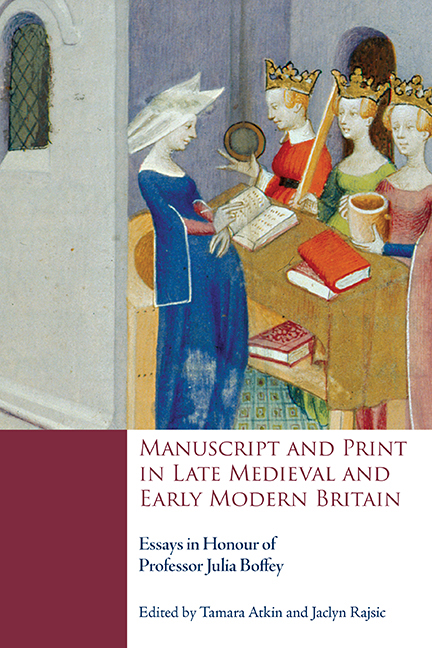 Manuscript and Print in Late Medieval and Early Modern Britain
Manuscript and Print in Late Medieval and Early Modern Britain Book contents
- Frontmatter
- Contents
- List of Illustrations
- List of Contributors
- Acknowledgements
- List of Abbreviations
- Introduction
- PRODUCING TEXTS
- READING INFLUENCE
- 8 Writing Revelation: The Book of Margery Kempe
- 9 ‘What strange ruins’: Reading Back to Thebes
- 10 Tyre in Africa: Dido's Flight and Sallust's Jugurtha
- 11 Trinitarian Piety and Married Chastity in The Pistel of Swete Susan
- 12 True Image? Alternative Veronicas in Late Medieval England
- 13 The Curelesse Wound: Henry Howard, Earl of Surrey and the Poetry of Blood
- Afterword
- Julia Boffey: A Bibliography
- Manuscript Index
- General Index
- Tabula Gratulatoria
12 - True Image? Alternative Veronicas in Late Medieval England
from READING INFLUENCE
Published online by Cambridge University Press: 06 September 2019
- Frontmatter
- Contents
- List of Illustrations
- List of Contributors
- Acknowledgements
- List of Abbreviations
- Introduction
- PRODUCING TEXTS
- READING INFLUENCE
- 8 Writing Revelation: The Book of Margery Kempe
- 9 ‘What strange ruins’: Reading Back to Thebes
- 10 Tyre in Africa: Dido's Flight and Sallust's Jugurtha
- 11 Trinitarian Piety and Married Chastity in The Pistel of Swete Susan
- 12 True Image? Alternative Veronicas in Late Medieval England
- 13 The Curelesse Wound: Henry Howard, Earl of Surrey and the Poetry of Blood
- Afterword
- Julia Boffey: A Bibliography
- Manuscript Index
- General Index
- Tabula Gratulatoria
Summary
REFLECTING UPON HER SECOND RE VELATION OF 1373 – a vision of Christ's face – Julian of Norwich compares it to the Roman Vernicle, Christ's likeness as received by St Veronica:
It made me to thinke of the holy vernacle of Rome which he hath portrayed with his owne blissid face when he was in his herd Passion, wilfully going to his deth, and often chongyng of colour. Of the brownehede and blakehede, reulihede and lenehede of this image, many mervel how it might be, stondyng he portrayed it with his blissid face which is the fairehede of heavyn … Than how might this image be so discolouring and so fer fro faire?… And there it seith of the vernacle of Rome, it mevyth be dyvers chongyng of colour and chere, sometyme more comfortably and lively, and sometime more reuly and deadly …
The Vernicle's unique claim is to preserve an unmediated likeness of the face of God, the direct impress of his features, not as imagined and depicted by another, not made by human hand. The Vernicle became a universally known image of Christ in later medieval England, and an emblem of each individual's face-to-face encounter with God at judgement. Yet, what was supposedly a uniquely authoritative record of Christ's countenance became familiar in widely varying and even contradictory versions. With her ‘many marvel how it might be’, Julian implies a tradition of bewilderment at the baffling obscurity and fluctuating ‘mouvance’ of the Vernicle. After briefly surveying the Vernicle's earlier history, this chapter focuses on the paradoxes of the Vernicle's developing story in later medieval England.
The Vernicle's name is formed from Veronica's – understood to derive from vera icon, ‘true image’ – and both woman and image may be called Veronica. In early phases of the Veronica legend, in Cura Sanitatis Tiberii (c.600 ad) and Vindicta Salvatoris (c.700), a woman possesses an image of Christ on cloth which has healing powers – but as yet there is no miraculous explanation of how the image was created.
- Type
- Chapter
- Information
- Manuscript and Print in Late Medieval and Early Modern BritainEssays in Honour of Professor Julia Boffey, pp. 219 - 240Publisher: Boydell & BrewerPrint publication year: 2019


